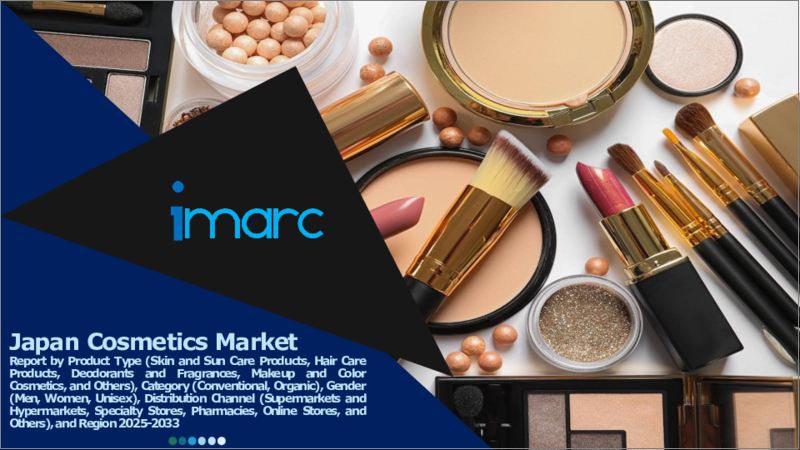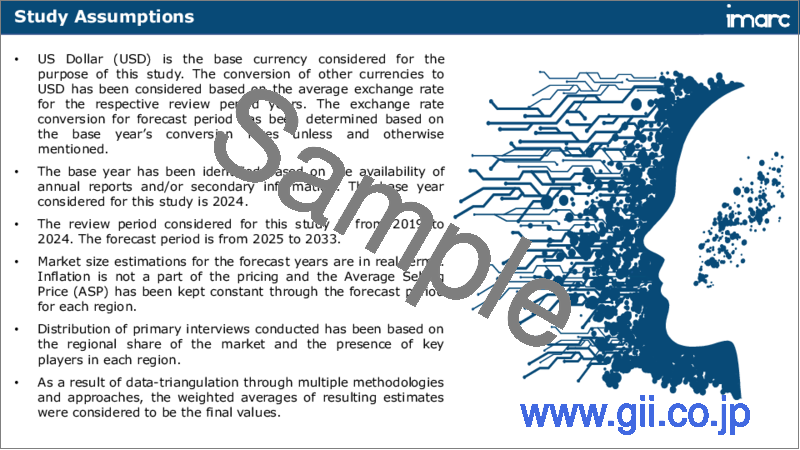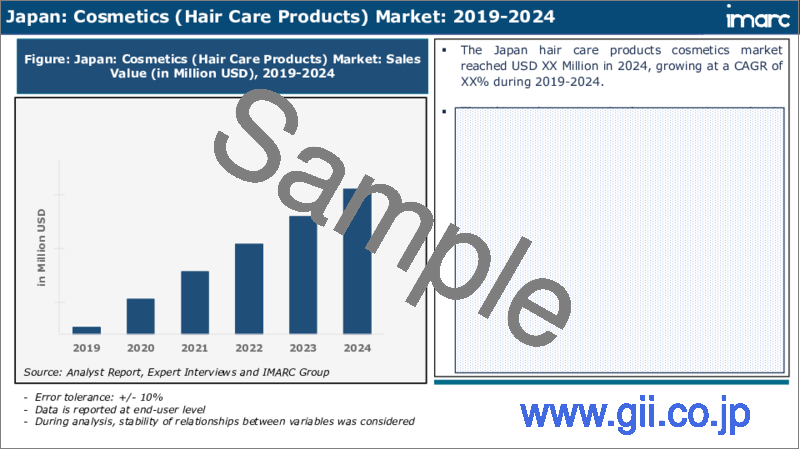|
|
市場調査レポート
商品コード
1609749
日本の化粧品市場レポート:製品タイプ、カテゴリー、ジェンダー別、流通チャネル、地域別、2025年~2033年Japan Cosmetics Market Report by Product Type, Category, Gender, Distribution Channel, and Region 2025-2033 |
||||||
カスタマイズ可能
|
|||||||
| 日本の化粧品市場レポート:製品タイプ、カテゴリー、ジェンダー別、流通チャネル、地域別、2025年~2033年 |
|
出版日: 2024年12月05日
発行: IMARC
ページ情報: 英文 117 Pages
納期: 5~7営業日
|
- 全表示
- 概要
- 目次
日本の化粧品市場の市場規模は2024年に275億米ドルに達しました。今後、IMARC Groupは、市場は2033年までに399億米ドルに達し、2025年から2033年にかけて4.2%の成長率(CAGR)を示すと予測しています。高齢者人口の増加、急速な技術進歩と製品の革新、オーガニック製品や天然製品に対する需要の高まり、日本政府による支援政策の実施などが、市場を牽引する主な要因となっています。
本レポートで扱う主な質問
- 日本の化粧品市場はこれまでどのように推移し、今後どのように推移するのか?
- COVID-19が日本の化粧品市場に与えた影響は?
- 日本の化粧品市場の製品タイプ別の内訳は?
- 日本の化粧品市場のカテゴリー別の内訳は?
- 日本の化粧品市場のジェンダー別での内訳は?
- 日本の化粧品市場の流通チャネル別の内訳は?
- 日本の化粧品市場のバリューチェーンにはどのような段階がありますか?
- 日本の化粧品市場の主な促進要因と課題は何か?
- 日本の化粧品市場の構造と主要プレーヤーは?
- 日本の化粧品市場の競合の程度は?
- 日本の化粧品市場規模は?
目次
第1章 序文
第2章 調査範囲と調査手法
- 調査の目的
- ステークホルダー
- データソース
- 市場推定
- 調査手法
第3章 エグゼクティブサマリー
第4章 日本の化粧品市場:イントロダクション
- 概要
- 市場力学
- 業界動向
- 競合情報
第5章 日本の化粧品市場情勢
- 過去および現在の市場動向(2019年~2024年)
- 市場予測(2025-2033)
第6章 日本の化粧品市場:製品タイプ別の内訳
- スキンケア・日焼けケア製品
- ヘアケア製品
- デオドラントとフレグランス
- メイクアップとカラー化粧品
- その他
第7章 日本の化粧品市場:カテゴリー別の内訳
- 従来型
- オーガニック
第8章 日本の化粧品市場:ジェンダー別の内訳
- 男性
- 女性
- ユニセックス
第9章 日本の化粧品市場:流通チャネル別の内訳
- スーパーマーケットとハイパーマーケット
- 専門店
- 薬局
- オンラインストア
- その他
第10章 日本の化粧品市場:競合情勢
- 概要
- 市場構造
- 市場プレーヤーのポジショニング
- 主要成功戦略
- 競合ダッシュボード
- 企業評価象限
第11章 主要企業のプロファイル
第12章 日本の化粧品市場:業界分析
- 促進要因・抑制要因・機会
- ポーターのファイブフォース分析
- バリューチェーン分析
第13章 付録
The Japan cosmetics market size reached USD 27.5 Billion in 2024. Looking forward, IMARC Group expects the market to reach USD 39.9 Billion by 2033, exhibiting a growth rate (CAGR) of 4.2% during 2025-2033. The rising geriatric population, rapid technological advancements and product innovations, growing demand for organic and natural products, and the implementation of supportive policies by the Government of Japan represent some of the key factors driving the market.
Cosmetics represent an extensive assortment of products that are designed to enhance or adjust the body's visual appeal or fragrance. It includes items, such as makeup, skincare, hair care, fragrances, and personal care products, among others. These commodities are meticulously formulated with diverse ingredients, including coloring agents, emollients, preservatives, humectants, and fragrant substances to suit varied skin types and aesthetic preferences. Cosmetics serve a crucial role in skincare routines, hairstyling, aesthetic amplification, personal hygiene, flaw masking, self-esteem boosting, and maintaining a professional demeanor. They aid in rejuvenating the skin, encouraging healthier hair, providing sun protection, boosting physical charm, and fostering elevated self-confidence. Cosmetics also present opportunities for relaxation, self-indulgence, expressing personal style, enhancing the longevity of makeup, and improving personal grooming habits. In addition, the regular application of cosmetics enhances personal cleanliness, delays the onset of aging, protects the skin from excessive damage from free radicals, and cultivates overall wellness.
Japan Cosmetics Market Trends:
The Japan cosmetics market is experiencing robust growth propelled by the increasing geriatric population, which requires anti-aging products to improve skin texture, enhance elasticity, and reduce wrinkles, dullness, age spots, and other signs of aging. Furthermore, the rapid technological advancements and product innovations by Japanese cosmetic companies to attract domestic and international consumers is contributing to the Japan cosmetics market growth. Along with this, the growing demand for natural and organic cosmetics that are safe, eco-friendly, and do not adversely impact skin is boosting the market growth. Apart from this, the growing number of beauty-conscious individuals that value high-quality skincare and makeup products is acting as another growth-inducing factor. Moreover, aggressive promotional and branding activities by manufacturers through influencer marketing, celebrity endorsement, and television (TV) commercial to raise product awareness, increase brand visibility, and enhance market penetration is positively influencing the market growth. Apart from this, the widespread prevalence of Kawaii or cute culture in Japan is facilitating the demand for specific makeup products. Moreover, the implementation of supportive policies by the Government of Japan to encourage the establishment of international cosmetic brands through incentives and tax benefits is favoring the market growth. Besides this, the presence of a strong retail network comprising supermarkets, pharmacies, drug stores, and malls, which ensures easy access to wide-ranging cosmetics, is catalyzing the market growth. Other factors, including the growing expenditure capacities of consumers, extensive research and development activities, rising focus on health and wellness among individuals, and emerging trends of male grooming, are anticipated to drive the market growth.
Key Market Segmentation:
Product Type Insights:
- Skin and Sun Care Products
- Hair Care Products
- Deodorants and Fragrances
- Makeup and Color Cosmetics
- Others
Category Insights:
- Conventional
- Organic
Gender Insights:
- Men
- Women
- Unisex
Distribution Channel Insights:
- Supermarkets and Hypermarkets
- Specialty Stores
- Pharmacies
- Online Stores
- Others
Competitive Landscape:
- The report has also provided a comprehensive analysis of the competitive landscape in the market. Competitive analysis such as market structure, key player positioning, top winning strategies, competitive dashboard, and company evaluation quadrant has been covered in the report. Also, detailed profiles of all major companies have been provided. The companies in the market are adopting various strategic initiatives including new product launches and business alliances to gain a significant Japan cosmetics market share.
Key Questions Answered in This Report:
- How has the Japan cosmetics market performed so far and how will it perform in the coming years?
- What has been the impact of COVID-19 on the Japan cosmetics market?
- What is the breakup of the Japan cosmetics market on the basis of product type?
- What is the breakup of the Japan cosmetics market on the basis of category?
- What is the breakup of the Japan cosmetics market on the basis of gender?
- What is the breakup of the Japan cosmetics market on the basis of distribution channel?
- What are the various stages in the value chain of the Japan cosmetics market?
- What are the key driving factors and challenges in the Japan cosmetics market?
- What is the structure of the Japan cosmetics market and who are the key players?
- What is the degree of competition in the Japan cosmetics market?
- How big is the cosmetics market in Japan?
Table of Contents
1 Preface
2 Scope and Methodology
- 2.1 Objectives of the Study
- 2.2 Stakeholders
- 2.3 Data Sources
- 2.3.1 Primary Sources
- 2.3.2 Secondary Sources
- 2.4 Market Estimation
- 2.4.1 Bottom-Up Approach
- 2.4.2 Top-Down Approach
- 2.5 Forecasting Methodology
3 Executive Summary
4 Japan Cosmetics Market - Introduction
- 4.1 Overview
- 4.2 Market Dynamics
- 4.3 Industry Trends
- 4.4 Competitive Intelligence
5 Japan Cosmetics Market Landscape
- 5.1 Historical and Current Market Trends (2019-2024)
- 5.2 Market Forecast (2025-2033)
6 Japan Cosmetics Market - Breakup by Product Type
- 6.1 Skin and Sun Care Products
- 6.1.1 Overview
- 6.1.2 Historical and Current Market Trends (2019-2024)
- 6.1.3 Market Forecast (2025-2033)
- 6.2 Hair Care Products
- 6.2.1 Overview
- 6.2.2 Historical and Current Market Trends (2019-2024)
- 6.2.3 Market Forecast (2025-2033)
- 6.3 Deodorants and Fragrances
- 6.3.1 Overview
- 6.3.2 Historical and Current Market Trends (2019-2024)
- 6.3.3 Market Forecast (2025-2033)
- 6.4 Makeup and Color Cosmetics
- 6.4.1 Overview
- 6.4.2 Historical and Current Market Trends (2019-2024)
- 6.4.3 Market Forecast (2025-2033)
- 6.5 Others
- 6.5.1 Historical and Current Market Trends (2019-2024)
- 6.5.2 Market Forecast (2025-2033)
7 Japan Cosmetics Market - Breakup by Category
- 7.1 Conventional
- 7.1.1 Overview
- 7.1.2 Historical and Current Market Trends (2019-2024)
- 7.1.3 Market Forecast (2025-2033)
- 7.2 Organic
- 7.2.1 Overview
- 7.2.2 Historical and Current Market Trends (2019-2024)
- 7.2.3 Market Forecast (2025-2033)
8 Japan Cosmetics Market - Breakup by Gender
- 8.1 Men
- 8.1.1 Overview
- 8.1.2 Historical and Current Market Trends (2019-2024)
- 8.1.3 Market Forecast (2025-2033)
- 8.2 Women
- 8.2.1 Overview
- 8.2.2 Historical and Current Market Trends (2019-2024)
- 8.2.3 Market Forecast (2025-2033)
- 8.3 Unisex
- 8.3.1 Overview
- 8.3.2 Historical and Current Market Trends (2019-2024)
- 8.3.3 Market Forecast (2025-2033)
9 Japan Cosmetics Market - Breakup by Distribution Channel
- 9.1 Supermarkets and Hypermarkets
- 9.1.1 Overview
- 9.1.2 Historical and Current Market Trends (2019-2024)
- 9.1.3 Market Forecast (2025-2033)
- 9.2 Specialty Stores
- 9.2.1 Overview
- 9.2.2 Historical and Current Market Trends (2019-2024)
- 9.2.3 Market Forecast (2025-2033)
- 9.3 Pharmacies
- 9.3.1 Overview
- 9.3.2 Historical and Current Market Trends (2019-2024)
- 9.3.3 Market Forecast (2025-2033)
- 9.4 Online Stores
- 9.4.1 Overview
- 9.4.2 Historical and Current Market Trends (2019-2024)
- 9.4.3 Market Forecast (2025-2033)
- 9.5 Others
- 9.5.1 Historical and Current Market Trends (2019-2024)
- 9.5.2 Market Forecast (2025-2033)
10 Japan Cosmetics Market - Competitive Landscape
- 10.1 Overview
- 10.2 Market Structure
- 10.3 Market Player Positioning
- 10.4 Top Winning Strategies
- 10.5 Competitive Dashboard
- 10.6 Company Evaluation Quadrant
11 Profiles of Key Players
- 11.1 Company A
- 11.1.1 Business Overview
- 11.1.2 Product Portfolio
- 11.1.3 Business Strategies
- 11.1.4 SWOT Analysis
- 11.1.5 Major News and Events
- 11.2 Company B
- 11.2.1 Business Overview
- 11.2.2 Product Portfolio
- 11.2.3 Business Strategies
- 11.2.4 SWOT Analysis
- 11.2.5 Major News and Events
- 11.3 Company C
- 11.3.1 Business Overview
- 11.3.2 Product Portfolio
- 11.3.3 Business Strategies
- 11.3.4 SWOT Analysis
- 11.3.5 Major News and Events
- 11.4 Company D
- 11.4.1 Business Overview
- 11.4.2 Product Portfolio
- 11.4.3 Business Strategies
- 11.4.4 SWOT Analysis
- 11.4.5 Major News and Events
- 11.5 Company E
- 11.5.1 Business Overview
- 11.5.2 Product Portfolio
- 11.5.3 Business Strategies
- 11.5.4 SWOT Analysis
- 11.5.5 Major News and Events
12 Japan Cosmetics Market - Industry Analysis
- 12.1 Drivers, Restraints, and Opportunities
- 12.1.1 Overview
- 12.1.2 Drivers
- 12.1.3 Restraints
- 12.1.4 Opportunities
- 12.2 Porters Five Forces Analysis
- 12.2.1 Overview
- 12.2.2 Bargaining Power of Buyers
- 12.2.3 Bargaining Power of Suppliers
- 12.2.4 Degree of Competition
- 12.2.5 Threat of New Entrants
- 12.2.6 Threat of Substitutes
- 12.3 Value Chain Analysis






